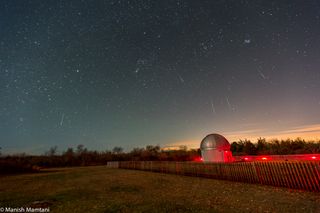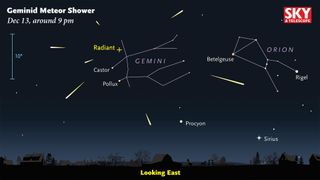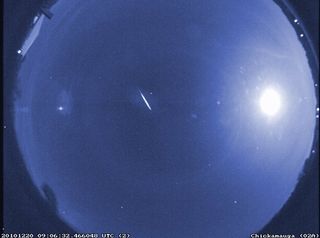Geminid Meteor Shower, Best of the Year, Peaks Sunday: Watch It Live

The Geminid meteor shower will be in full swing the nights of Dec. 13 and Dec. 14, and experts are saying it's going to be the best meteor shower of 2015.
The online Slooh Community Observatory will air a live webcast about the Geminids on Monday, Dec. 13 beginning at 6 p.m. EST (2300 GMT). Hosted by Slooh's Community Manager and astronomy expert Paul Cox, the webcast will feature views of the Geminids from five countries on four continents. Viewers will also learn more about what causes this shower of shooting stars. You can watch the webcast directly at http://www.slooh.com.
You can also watch the Geminid meteor shower webcast on Space.com, courtesy of Slooh. On the nights of Dec. 13 and Dec. 14, NASA has estimated that under ideal viewing conditions, stargazers may see as many as 100 meteors per hour. [Awesome Photos of the 2014 Geminid Meteor Shower]
The "shooting stars" seen during a meteor shower are bits of rock burning up in Earth's atmosphere. The annual Geminid meteor shower is caused by debris from an object called 3200 Phaethon. According to NASA, 3200 Phaethon was "long thought to be an asteroid," but is now classified as an "extinct comet," meaning the water ice and other volatiles on its surface have totally evaporated, leaving only a rocky object. Earth passes through the debris field once per year, and the "shooting stars" appear to radiate from a point in the constellation Gemini — hence the name "Geminid."

The Slooh webcast will include more than views of the meteor shower. In an email to Space.com, a Slooh representative said that viewers will "learn about the surprising 'rock comet' that causes this active shower, and dive into the mythology of the Gemini twins, Castor and Pollux. We'll also tell you all about how you can hear meteors as well as see them, and give you a quick tutorial on taking your own meteor images."
NASA's Marshall Space Flight Center in Huntsville, Alabama, will also host a live "Tweet chat" on the meteor shower on the night of Dec. 13, from 11 p.m. EST (0400 GMT Dec. 14) until 3 a.m. EST on Dec. 14 (0800 GMT Dec. 15). NASA experts — including Bill Cooke, Danielle Moser and Rhiannon Blaauw — will be on hand to provide commentary on the meteor shower and answer questions. Members of the public can tweet their questions to "@NASA_Marshall" or simply use the hashtag "#askNASA."
If you're in the Northern Hemisphere, be sure to bundle up before going outside. Keep an eye on weather reports to find out when the sky will be clear for viewing. Sky and Telescope magazine advises giving your eyes time to adjust to the darkness — at least 20 minutes should do the trick.
Get the Space.com Newsletter
Breaking space news, the latest updates on rocket launches, skywatching events and more!
The Royal Astronomical Society (RAS) in the United Kingdom states that meteors are best seen with the naked eye, so no telescope or binoculars are required. Viewing conditions may vary depending on what time viewers look skyward.

"Meteor watchers may want to look at different times during the night," RAS representatives said in a statement. "Because of the rotation of the Earth, in the early evening, the edge of the cloud of debris that makes up the Geminids skims the atmosphere, leading to a few 'Earth grazer' meteors that can have long paths across the sky. Later on in the night, observers are looking up as their part of the Earth is facing right into the debris, so the number of meteors is usually much higher."
If you can't see the meteors during the Geminid meteor shower, you could try listening to them. The website LiveMeteors.com captures radio signals that are reflected off the "trail" of a meteor. The trail includes the streak of light seen by skywatchers, as well as disrupted air molecules. According to the website, "This trail is capable of reflecting radio waves from transmitters located on the ground, similar to light reflecting from a mirrored surface. Meteor radio wave reflections are also called meteor echoes, or pings." The page also provides a visualization of the spectrum of the meteor echoes.
Editor's note: If you capture an amazing photo of the Geminid meteor shower, or any other night sky view, and you'd like to share it with Space.com and our news partners for a story or gallery, send images and comments in to managing editor Tariq Malik at: spacephotos@space.com.
Follow Calla Cofield @callacofield. Follow us @Spacedotcom, Facebook and Google+. Original article on Space.com.
Join our Space Forums to keep talking space on the latest missions, night sky and more! And if you have a news tip, correction or comment, let us know at: community@space.com.

Calla Cofield joined Space.com's crew in October 2014. She enjoys writing about black holes, exploding stars, ripples in space-time, science in comic books, and all the mysteries of the cosmos. Prior to joining Space.com Calla worked as a freelance writer, with her work appearing in APS News, Symmetry magazine, Scientific American, Nature News, Physics World, and others. From 2010 to 2014 she was a producer for The Physics Central Podcast. Previously, Calla worked at the American Museum of Natural History in New York City (hands down the best office building ever) and SLAC National Accelerator Laboratory in California. Calla studied physics at the University of Massachusetts, Amherst and is originally from Sandy, Utah. In 2018, Calla left Space.com to join NASA's Jet Propulsion Laboratory media team where she oversees astronomy, physics, exoplanets and the Cold Atom Lab mission. She has been underground at three of the largest particle accelerators in the world and would really like to know what the heck dark matter is. Contact Calla via: E-Mail – Twitter
